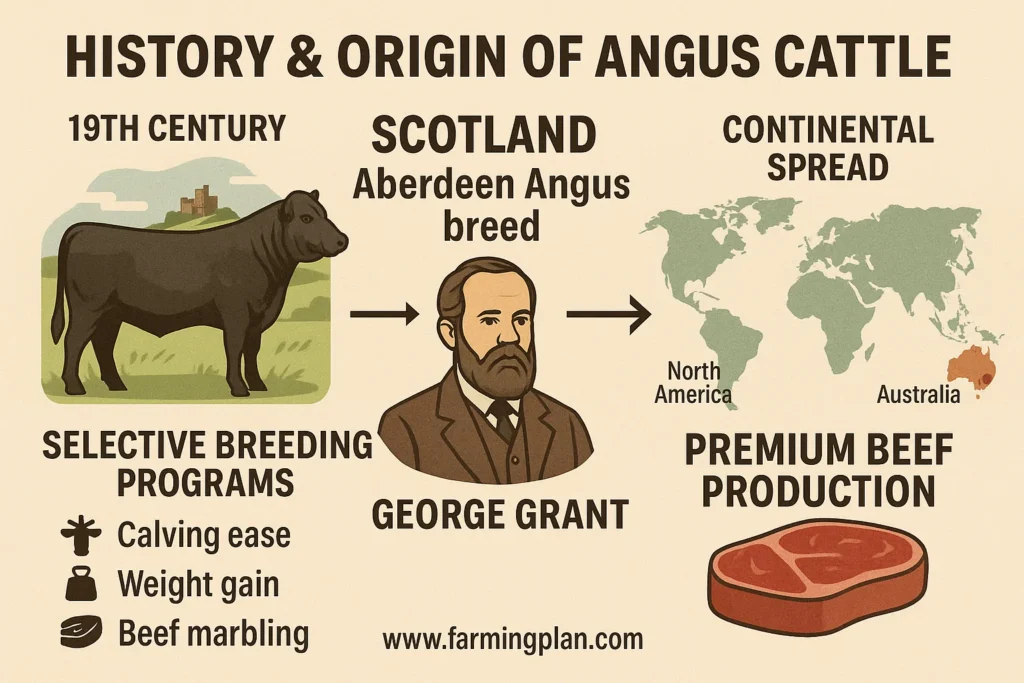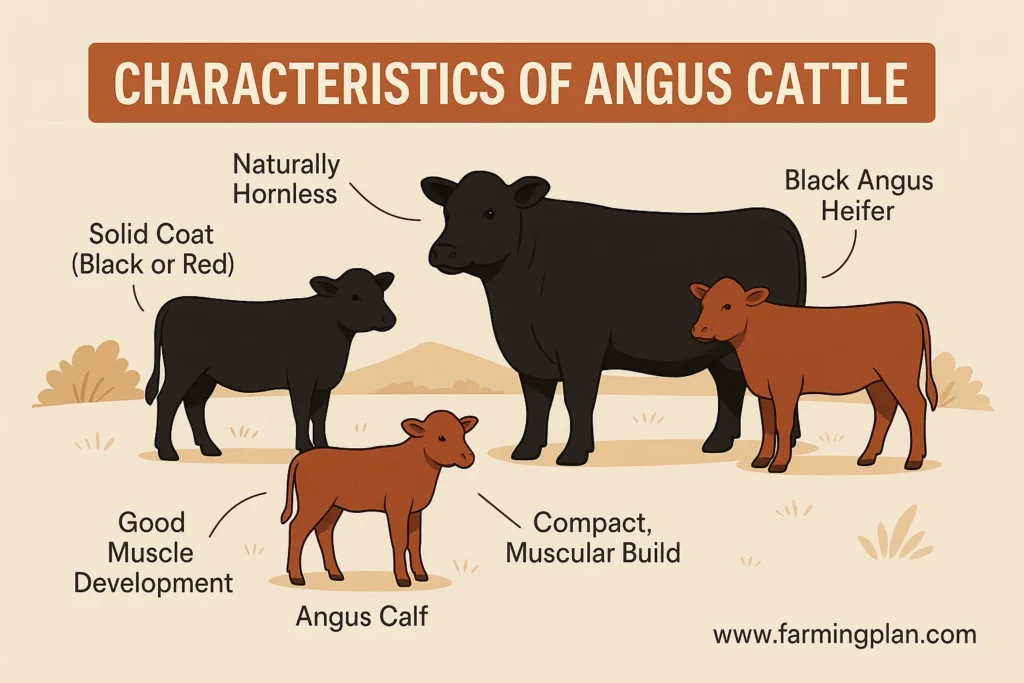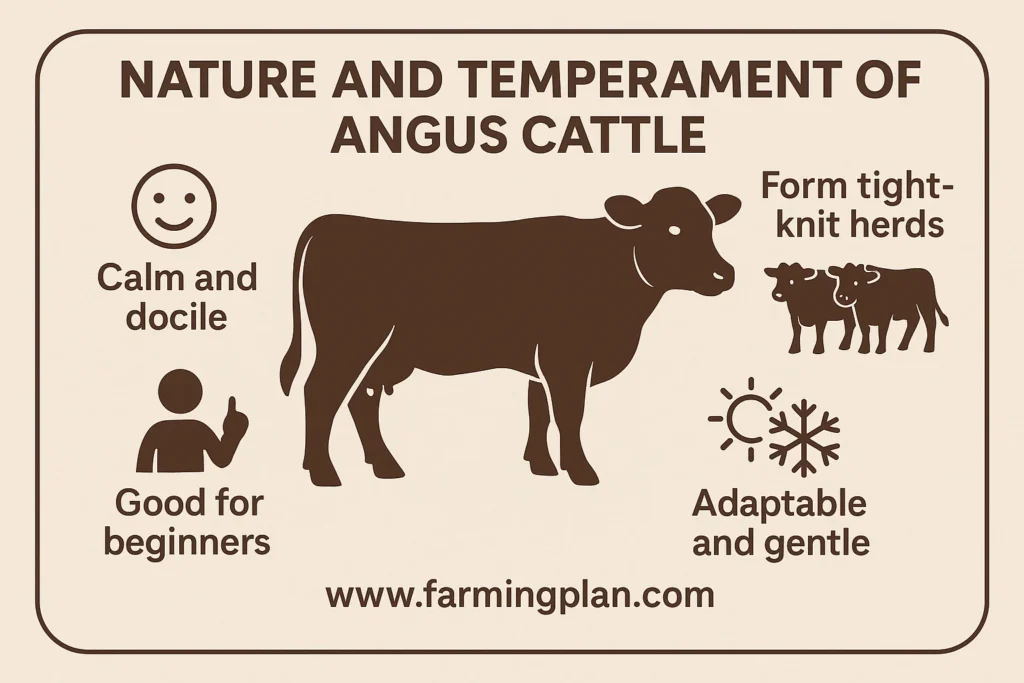If you’ve ever wondered why Angus cattle hold such a special place in beef farming, you’re in for a treat. As someone who’s worked closely with this remarkable breed of cattle, I’ve seen firsthand how angus cows and angus bulls combine great temperament, solid build, and incredible beef quality. Whether you’re a breeder, a hobby farmer, or just curious about cattle breeds, understanding Angus cattle will give you insight into why they’ve become a cornerstone of the beef industry worldwide. From their distinct black or red coats to their history rooted in Scotland, these animals offer more than just meat—they bring a legacy of quality and hardiness.

History & Origin of Angus Cattle
Angus cattle trace back to the 19th century in Scotland, where the Aberdeen Angus breed first appeared. George Grant, often credited as a pioneer, helped develop this hornless cattle breed that quickly caught farmers’ attention for its hardiness and beef quality. The breed spread rapidly across continents, reaching North America and Australia, thanks to organizations like the American Aberdeen-Angus Breeders’ Association and the Angus Society of Australia.

Over centuries, Angus cattle became synonymous with premium beef production. Selective breeding programs, a key factor in their evolution, refined traits like calving ease, weight gain, and beef marbling, setting Angus apart from other breeds like Shorthorns and Galloway. Today, Angus cattle carry a legacy that reflects both their Scottish roots and their global impact on the beef industry.
Read More: Lowline Cattle: Best Small-Farm Breed
Characteristics of Angus Cattle
One of the first things you notice about Angus cattle is their sleek, solid coat—usually black but sometimes red, as seen in red angus cattle. These animals are naturally hornless, which makes handling easier and safer on farms. Angus cattle come in different sizes, including the popular lowline angus cows that are smaller but just as robust.

Their calves, whether angus calves or black angus heifers, show early signs of good muscle development and strong health. Angus cattle typically have a compact, muscular build, contributing to their reputation as one of the best beef cattle breeds. Their growth rate, weight, and even temperament make them ideal for many farmers who want quality meat and manageable animals.
Read More: Highland Cattle: Discover These Gentle Giants
Nature and Temperament of Angus Cattle
In my experience, Angus cattle are surprisingly calm and easy to work with, which makes them perfect for both small farms and large commercial operations. These animals tend to form tight-knit herds and are quite social, showing gentle behavior around humans. This docility means you don’t need to be an expert cattle handler to start raising Angus.

Their temperament also makes them good for beginners or hobby farmers looking for a manageable, stress-free breed. Despite their beefy build, they are not aggressive and adapt well to different climates and pastures. This adaptability, balancing strength and gentleness, is part of why Angus cattle have become so popular and should reassure you about your ability to manage this breed.
Read More: Boran Cattle: A Path to Profitable Farming
Food and Diet for Angus Cattle
Feeding Angus cattle the right diet is key to getting the best beef quality and healthy animals. As a responsible cattle farmer, you should understand that Angus thrive on high-quality pasture forages, which keep feeding costs reasonable while supporting natural growth. Good pasture includes a mix of grasses and legumes that supply the nutrients cattle need.
Supplementing with minerals and occasional grain helps especially during winter or dry seasons when pastures are less nutritious. It’s important to avoid sudden changes in diet to prevent digestive issues. Keeping a consistent feeding routine ensures Angus cattle maintain good weight without suffering from over- or underfeeding.
Consistent Feeding And Calm Handling Improve Angus Cattle Growth And Beef Quality.
Usage and Purpose of Angus Cattle
Angus cattle are mainly raised for their beef, which is famous for its marbling, tenderness, and flavor. Commercial herds use Angus as a foundation breed because of their meat quality and reliable calving traits. Farmers often select angus bulls and cows to improve herd genetics through selective breeding programs.
Besides beef production, Angus cattle sometimes appear in shows and breed exhibitions. They also make great crossbreeds, helping improve beef quality in other cattle lines. The Angus Difference is a recognized mark of quality that consumers trust, making this breed a smart choice for anyone serious about beef farming.
Special Features of Angus Cattle
A standout feature of Angus cattle is their hornless nature, which reduces injury risks. Their beef is prized for rich marbling, meaning more flavorful and tender cuts for consumers. The breed’s natural calving ease saves farmers a lot of headaches, especially during busy calving seasons.
Variants like lowline angus bulls offer smaller, manageable stock without sacrificing beef quality. Plus, Angus cattle adapt well to different environments, from open pastures to intensive feedlot systems. Their selective breeding history has fine-tuned many traits, including growth rate and disease resistance.
Health Issues and Prevention for Angus Cattle
Like all livestock, Angus cattle face health challenges like respiratory infections and parasites. In my experience, regular health checks are essential to catch problems early. Common issues include calving difficulties, which are less frequent with Angus but still something to watch for.
Vaccinations, parasite control, and balanced nutrition go a long way in keeping your herd healthy. Creating a calm environment and minimizing stress also help prevent disease outbreaks. Keeping detailed records helps you track health patterns and improve herd management over time.
Step-by-Step Farming Guide for Angus Cattle
Raising Angus cattle can be incredibly rewarding, but it takes the right steps to do it well. In this step-by-step farming guide, I’ll walk you through everything—from setting up your pasture to caring for calves—so you can build a healthy, thriving Angus herd with confidence. Let’s dive in and get your farm running smoothly!
Step 1: Setting Up Your Farm for Angus Cattle
Start with good fencing and ample pasture. Angus cattle love room to roam but also need protection from predators. Invest in quality pasture grasses—this keeps feeding costs down and helps your cattle grow naturally. Consider shelter for harsh weather to keep your herd comfortable.
Step 2: Selecting and Buying Your Angus Stock
Look for reputable breeders offering healthy angus calves or cows. Check for traits like calm temperament, good conformation, and disease-free history. Buying from associations like the American Angus Association ensures quality stock. Introduce new animals slowly to your herd to prevent stress.
Step 3: Feeding and Nutrition Management
Maintain a steady feeding schedule with high-quality pasture and mineral supplements. Avoid sudden diet changes and monitor weight regularly. Provide fresh water daily and adjust feed during calving or cold months. Healthy nutrition equals happy, productive cattle.
Step 4: Breeding and Calving Practices
Choose bulls carefully to improve genetics. Watch cows closely during calving season to assist if needed. Record breeding dates and calving outcomes to refine your herd’s performance. Remember, Angus cattle usually calve easily but stay prepared.
Step 5: Daily Care and Health Monitoring
Spend time observing your herd each day. Look for signs of illness, injury, or distress. Keep vaccination and parasite control up to date. Clean water and proper shelter go a long way in preventing health issues. Keeping calm helps keep cattle calm too!
Expert Tips & Best Practices for Raising Angus Cattle
Selective Breeding for Better Herds: One of the smartest moves you can make is focusing on selective breeding. By choosing bulls and cows with the best traits—like good growth rates, easy calving, and strong health—you improve your herd generation after generation. This careful selection helps build a quality Angus stock that performs well in both the pasture and the market.
Upgrade Your Pasture Quality: Feeding costs can add up fast, so investing time and effort into improving your pasture pays off. Healthy, nutrient-rich forage supports your cattle’s natural growth and reduces the need for expensive supplements. Rotating pastures and planting diverse grasses and legumes keeps the land productive and your Angus cattle well-fed.
Watch Calving Closely: Calving can be a tricky time, even with a breed as reliable as Angus. Keeping a close eye on pregnant cows helps you catch any problems early and step in when necessary. Proper monitoring reduces calf loss and health issues for the mother, making your herd stronger and more productive.
Keep Detailed Herd Records: Good record-keeping is a game changer. Tracking breeding dates, health treatments, weights, and calving outcomes helps you spot patterns and make informed decisions. Organized records simplify management and let you identify which animals contribute most to your herd’s success.
Follow Beef Quality Assurance Standards: To ensure your Angus beef stands out in the market, stick to Beef Quality Assurance practices. This includes proper handling, nutrition, and health care to produce safe, high-quality meat. Following these guidelines builds consumer trust and improves your farm’s reputation.
Minimize Stress with Gentle Handling: Stress can seriously impact your cattle’s growth and meat quality. Keeping your handling calm and gentle helps your Angus cattle stay relaxed and healthy. A peaceful environment benefits both the animals and your daily farming routine.
Tip: “Consistent feeding and calm handling improve Angus cattle growth and beef quality.”
FAQ
What is the difference between Black Angus and Red Angus?
Black Angus cattle have solid black coats, while Red Angus have reddish-brown coats. Both produce high-quality beef and share similar traits.
How much does an Angus bull weigh?
Adult Angus bulls typically weigh between 1,800 and 2,400 pounds, depending on lineage and diet.
Are Angus cattle good for beginners?
Yes, their calm nature and manageable size make them suitable for new farmers and hobbyists.
What makes Angus beef different?
Angus beef is known for its excellent marbling, tenderness, and flavor, making it highly sought after by consumers.
Where can I buy Angus cattle?
You can buy Angus cattle from registered breeders, livestock auctions, or associations like the American Angus Association.
Conclusion
Raising Angus cattle means investing in a breed with a rich history, strong traits, and excellent beef quality. Their docile nature and ease of care make them perfect for both beginners and seasoned farmers. From their Scottish origins to their global presence, Angus cattle continue to shape the beef industry. Whether you’re managing a small herd or a commercial operation, Angus cattle offer reliability, tasty beef, and a rewarding farming experience.

